weight AUDI A5 CABRIOLET 2011 Owners Manual
[x] Cancel search | Manufacturer: AUDI, Model Year: 2011, Model line: A5 CABRIOLET, Model: AUDI A5 CABRIOLET 2011Pages: 364, PDF Size: 86.48 MB
Page 5 of 364
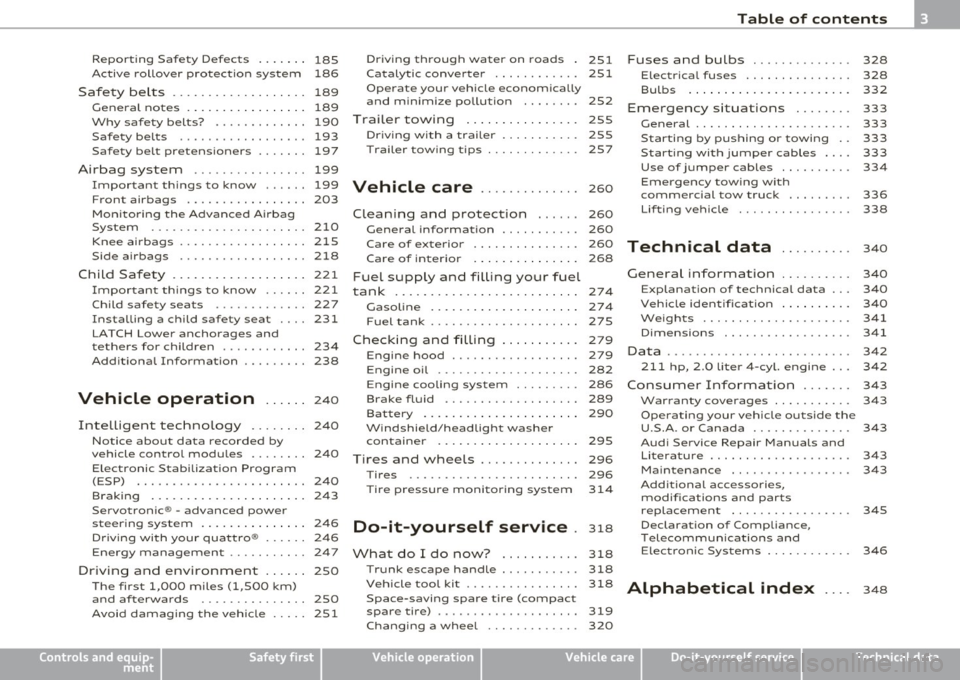
Reporting Safety Defects . . . . . . . 185
Active rollover protection system 186
Safety belts . . . . . . . . . . . . . . . . . . . 189
General notes ............ ..... 189
Why safety belts? ............. 190
Safety belts ........... ....... 193
Safety be lt pretensioners ....... 197
Airbag system ........ ........ 199
Important things to know ...... 199
F ron t airbags . . . . . . . . . . . . . . . . . 203
Mon itoring the Advanced Airbag
Sys tem .................. ... .
Knee airbags ................. .
S ide airbags . .. .............. .
Child Safety .. .. .......... .... .
Important things to know ..... .
Child safety seats ............ .
Installing a child safety seat ... .
LATCH Lowe r anchorages and
tethers for children ........... .
Additional Information 210
215
218
221
221
227
231
234
238
Vehicle operation
...... 240
Intelligent technology ........ 240
Notice abou t data recorded by
vehicle control modules . . . . . . . . 240
E lectronic Stab ilizat ion Program
(ESP) ................... ..... 240
Braking . . . . . . . . . . . . . . . . . . . . . . 24 3
Servotronic ® -advanced power
steer ing system .......... ..... 24 6
Driving with your quattro ® . . . . . . 246
En ergy management .......... . 24 7
Driving and environment ...... 250
The first 1,000 miles (1,50 0 km)
and afterwards ............... 250
Avoid damaging the vehicle ..... 251
Controls and equip
ment Safety first
Driving through w.ater
on roads . 251
Catalytic converter . . . . . . . . . . . . 251
Operate your vehicle economica lly
a nd minimize pollut ion . . . . . . . . 252
Trailer tow ing 255
Driving with a trailer . . . . . . . . . . . 255
T railer tow ing t ips ... .......... 257
Vehicle care ...... ........ 260
Cleaning and protect ion ...... 260
General information . . . . . . . . . . . 260
Care of exterior . . . . . . . . . . . . . . . 260
Care of interior . . . . . . . . . . . . . . . 268
Fuel supply and filling your fuel
tank ... ... ................ ....
274
Gasoline . ................ .... 274
Fu el tank .............. ....... 275
Checking and filling . . . . . . . . . . . 279
E ngine hood . . . . . . . . . . . . . . . . . . 279
Engin e oil . . . . . . . . . . . . . . . . . . . . 282
Engine cooling system . . . . . . . . . 286
Brake fl uid . . . . . . . . . . . . . . . . . . . 289
Bat tery . . . . . . . . . . . . . . . . . . . . . . 290
Windshield/headl ight washer
conta iner . . . . . . . . . . . . . . . . . . . . 295
Tire s and wheels ......... ..... 296
Ti res
296
Ti re pressure monitoring system 314
Do-it-yourself service . 318
What do I do now? 318
T runk escape handle ........... 318
Vehicle tool kit ............. ... 318
Space-saving spare tire (compact
spare tire) .................... 319
Changing a wheel . . . . . . . . . . . . . 320
Table of contents
Fuses and bulbs ............ . .
Electrica l fuses .............. .
Bul bs ..................... . .
Emergency situations ....... .
General ............ ......... .
Starting by pushing or towing ..
St arting with jumper cables ... .
Use of jumper cab les ....... .. .
Emergency tow ing w ith
commercial tow truck ........ .
Lift ing vehicle .... ........... .
Technical data
General informat ion
Explanation of technical data .. .
Vehicle identification ......... .
Weights .................... .
Dimensions ................. .
Data .......... ............... .
211 hp, 2.0 lit er 4 -cyl. e ngi ne .. .
Consum er Information ...... .
Warranty coverages .......... .
Operating your vehicle outside the
U.S.A. or Canada .......... ... .
Aud i Service Repair Manua ls and
Literature ......... .......... .
Maintenance ............... . .
Additional accessories ,
modif ications and parts
replacement ............... . .
Declaration of Compliance,
Telecommun ications and
E lectroni c Systems ........... .
Alphabetical index ....
328
328
332
333
333
333
333
334
336
338
340
3 40
3 40
340
341
341
342
342
343
343
343
343
343
345
3 46
3 48
Vehicle operation Vehicle care Do-it-yourself service Technical data
Page 105 of 364
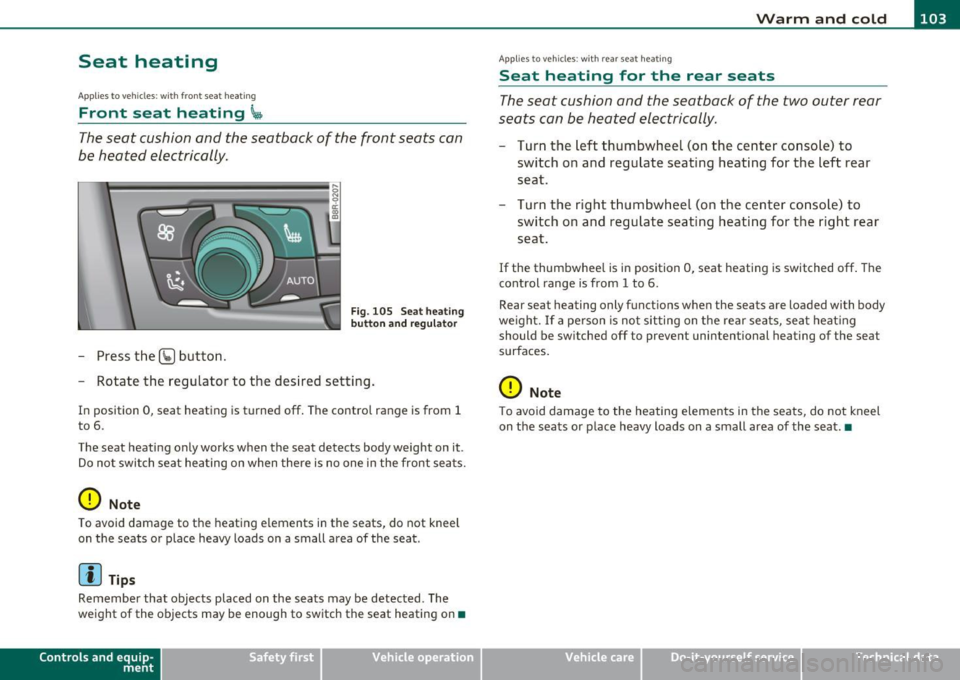
_________________________________________________ W_ a_ r_m _ a_ n_d_ c_ o_ ld _ ___.lfll
Seat heating
Ap plies to vehicles: w it h fr ont se at heat in g
Front seat heating ~
The seat cushion and the seatback of the front seats can
be heated electrically.
- Press the (g button.
s ci: ., m
Fig. 105 Seat heati ng
button and r egul ator
- Rotate the regulator to the des ired setting .
In position 0, seat heating is turned off . The contro l range is from 1
t o 6.
The seat heating only works when the seat detects body weight on it .
Do no t swi tc h s eat he ating on when the re is no one in the front se ats.
0 Note
To avoid damage to t he heat ing e lements in the seats, do not kneel
on t he seats o r place heavy loads on a small area of the seat .
[I) Tips
Remember that objects placed on the seats may be detected . The
we ight of the objects may be enough to switch the seat heating on •
Contro ls a nd e quip
m en t Vehicle
OP-eration
Applies to ve hicles : w ith rea r sea t heat ing
Seat heating for the rear seats
T he seat cushion and the seatback of the two outer rear
seats c an be heated electrically.
- Turn the left thumbwheel (on t he center conso le) to
switch o n and reg ulate seating heat ing fo r the left rear
seat.
Turn t he right t humbwhee l (on the center co nsole) to
switch on and regulate seat ing heating for the r ight rear
seat.
If the thumbwhee l is i n position 0, seat heating is switched off . The
control range is from 1 to 6.
Rear sea t heating only funct ions when the seats are loaded with body
we igh t. If a pe rson is no t sitting on t he rear sea ts, sea t heat ing
should be sw itched off to preve nt unintentional heating of the seat
surfaces.
0 Note
T o avoid damage to the heatin g elements in the seats, do not kneel
on the sea ts or p lace heavy loads on a small area of the seat .•
Vehicle care Do-it-yourselt service iTechnical data
Page 186 of 364
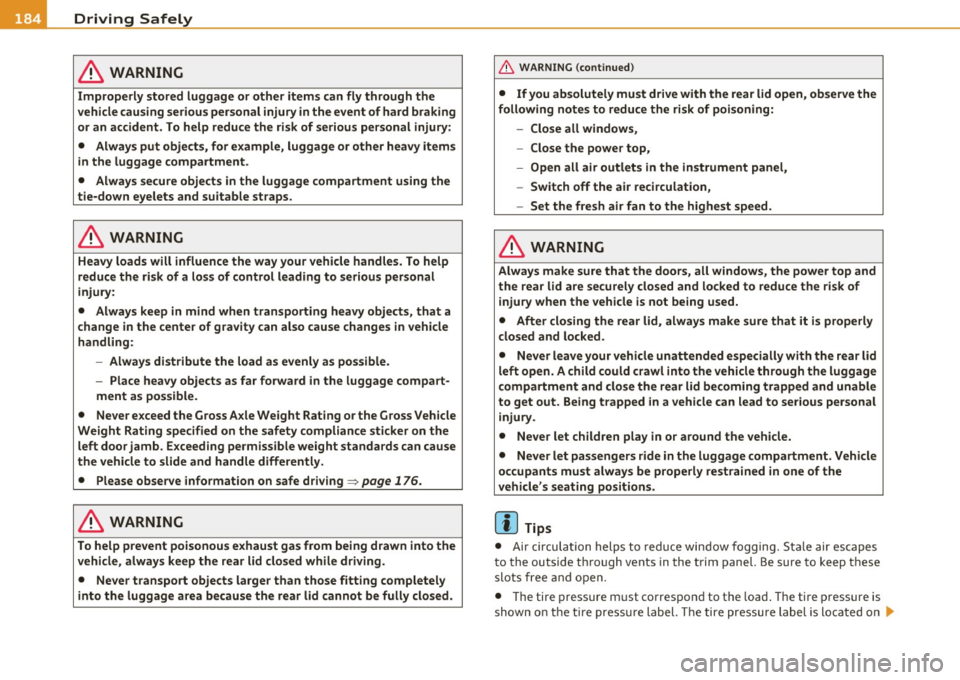
• ....__D_ r_iv _i_ n_, g=-- S_ a _ f_e _,Ly _ ______________________________________________ _
in. WARNING
Improperly stored luggage or other items can fly through the
vehicle causing serious personal injury in the event of hard braking
or an accident. To help reduce the risk of serious personal injury:
• Always put objects, for example, luggage or other heavy items
in the luggage compartment .
• Always secure objects in the luggage compartment using the
tie-down eyelets and suitable straps.
& WARNING
Heavy loads will influence the way your vehicle handles. To help
reduce the risk of a loss of control leading to serious personal
injury:
• Always keep in mind when transporting heavy objects, that a
change in the center of gravity can also cause changes in vehicle
handling:
-Always distribute the load as evenly as possible.
- Place heavy objects as far forward in the luggage compart-
ment as possible.
• Never exceed the Gross Axle Weight Rating or the Gross Vehicle
Weight Rating specified on the safety compliance sticker on the
left door jamb . Exceeding permissible weight standards can cause
the vehicle to slide and handle differently.
• Please observe information on safe driving=>
page 176.
in. WARNING
To help prevent poisonous exhaust gas from being drawn into the
vehicle, always keep the rear lid closed while driving.
• Never transport objects larger than those fitting completely
into the luggage area because the rear lid cannot be fully closed.
& WARNING (continued)
• If you absolutely must drive with the rear lid open , observe the
following notes to reduce the risk of poisoning:
-Close all windows,
- Close the power top,
- Open all air outlets in the instrument panel,
- Switch off the air recirculation,
- Set the fresh air fan to the highest speed.
in. WARNING
Always make sure that the doors, all windows, the power top and
the rear lid are securely closed and locked to reduce the risk of
injury when the vehicle is not being used.
• After closing the rear lid, always make sure that it is properly
closed and locked.
• Never leave your vehicle unattended especially with the rear lid
left open. A child could crawl into the vehicle through the luggage
compartment and close the rear lid becoming trapped and unable
to get out. Being trapped in a vehicle can lead to serious personal
injury.
• Never let children play in or around the vehicle.
• Never let passengers ride in the luggage compartment. Vehicle
occupants must always be properly restrained in one of the
vehicle's seating positions .
(I) Tips
• Air circulation helps to re du ce win dow fogging. Stale air escap es
to the outside th rough vents in the trim panel. Be sure to keep t hese
slots free and open.
• Th e tire pressure must correspond to the load . The tire pressure is
shown on the tir e pressure label. The tire pressure label is located on .,_
Page 187 of 364
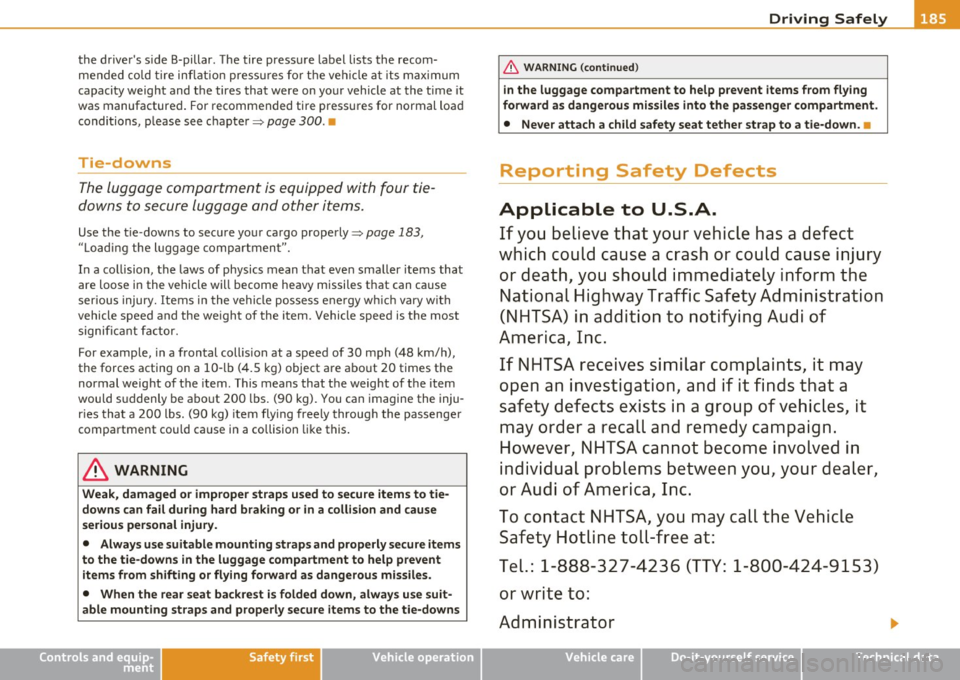
________________________________________________ D_ r_ i_ v _i_n ""'g "-- S_a_ f_ e_ l _,,y'-- __
the driver's s ide B-pillar. The tire pressure label lists the recom
mended co ld tire in flatio n press ures fo r th e ve hicle at its max imum
capacity weight and the tires that were on your vehicle at the time it
was manufactured . For recommended tire press ures for normal loa d
conditions, p lease see chapte r=>
page 300. •
Tie-downs
The luggage compartment is equippe d with four tie
do wns to sec ure lu gga ge a nd oth er items.
Use the t ie-downs to sec ure yo ur cargo properly=> page 183,
"Lo ad ing t he lugg age comp artmen t".
In a co llision, the laws of physics mean that even sma ller it ems that
are loose in the vehicle will become heavy missiles that can cause
ser iou s injury. Ite ms i n t he vehi cle pos se ss e ne rgy w hich va ry w it h
vehicle speed and the we ight of the item. Vehicle speed is t he most
s ig nifi ca nt f acto r.
For examp le, in a frontal coll is io n at a speed of 30 mph (48 km/h),
the forces acting on a 1 0-lb (4. 5 kg) object are a bout 20 times t he
normal weig ht o f the item. T his means that t he weight o f the ite m
wou ld s uddenly be a bo ut 200 lbs. (90 kg) . You can imagine the inju
r ies tha t a 200 lbs . (9 0 kg) item fly ing free ly throug h the p ass enge r
compartment cou ld cause i n a collision lik e this .
& WARNING
Weak , damaged or improper straps used to secure item s to tie
downs can fail during hard braking or in a collision and cause
serious personal injury.
• Always use suitable mounting straps and properly secure items
to the tie-downs in the luggage compartment to help prevent
items from shifting or flying forward as dangerous missiles.
• When the rear seat backre st is folded down, always use suit
able mounting straps and properly secure items to the tie-downs
Controls and equip ment Safety first Vehicle operation
& WARNING
(co ntinued )
in the luggage compartment to help prevent items from flying
forward as dangerous missiles into the passenger compartment.
• Never attach a child safety seat tether strap to a tie -down. •
Reporting Safety Defects
Applicable to U.S.A.
If you believe that your vehi cle has a defect
which could cause a crash or could cause injury
or death , you should immediately inform the
National Highway Traffic Safety Administration
(NHTSA) in addition to notifying Audi of
America, Inc.
If NHTSA receives similar complaints, it may
open an investigation, and if it find s that a
safety defe cts exist s in a group of vehicles, it
may o rder a recall and remedy campaign.
However , NHTSA cannot become involved in
individual problems between you, your dealer,
or Audi of America, Inc.
To contact NHTSA, you may call the Vehicle
Safety Hotline toll-free at:
Tel.: 1-888-327-4236 (TTY: 1-800-424-9153)
or write to:
Administrator
Vehicle care Do-it-yourself service Technical data
Page 192 of 364
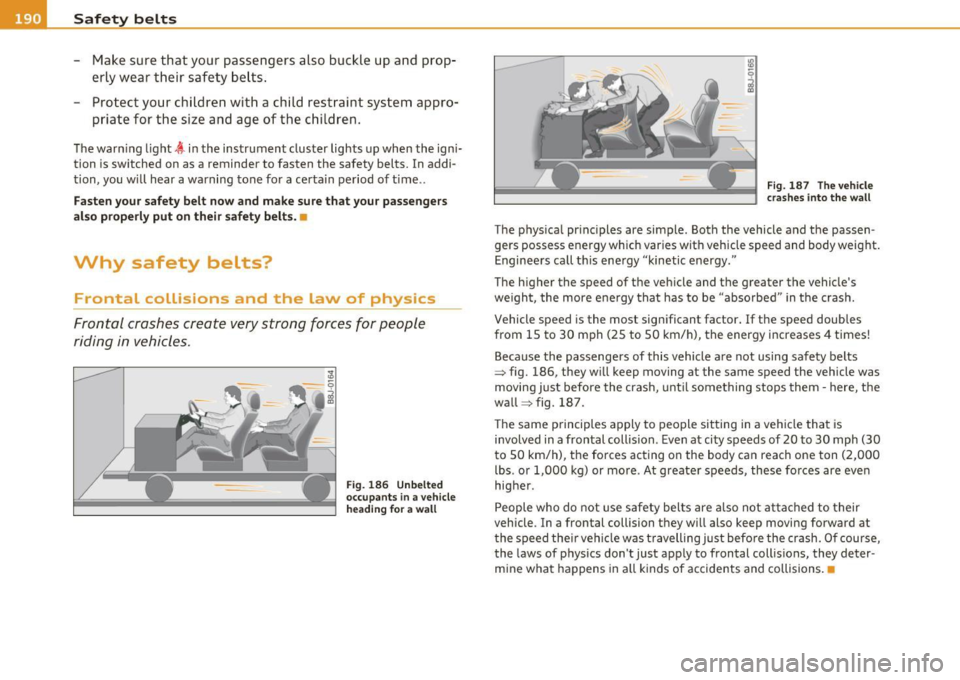
___ S_a_ f_ e_ t-= y'-- b_e_ l_ t _s _____________________________________________ _
- Make sure that your passengers also buckle up a nd prop
erly wear their safety belts .
- Protect your children wi th a child restraint system appro-
p ria te for the siz e and age of th e ch ild ren.
The warn ing light ~ in the instrument cluster lights up when the igni
tion is sw itched on as a reminder to fasten the safety belts. In addi
tion, you w ill hear a warning tone for a certa in period of t ime ..
Fasten your safety belt now and m ake sure that your passengers
also properly put on their safety belt s.•
Why safety belts?
Frontal collisions and the Law of physics
Frontal crashes c reate very s trong f orces for people
riding in vehicles.
Fig . 18 6 Unbelted
occu pa nt s in a v ehi cle
h ea ding f or a w all Fig. 18
7 The veh icl e
c ra she s into the wall
The p hys ica l pr inc iples are simple. Both the vehicle and the passen
gers possess energy wh ich var ies wit h veh icle speed and body weight.
Enginee rs call th is ene rgy "kinetic energy."
The higher the speed of the veh icle and the greater the vehicle's
we igh t, the more e ne rgy tha t has to be "abso rbed" in t he crash.
Vehicle speed is the most sign ificant factor.
If the speed doubles
from 15 to 30 mph (25 to 50 km/h), the energy increases 4 t imes!
Because the passenge rs of this vehicle a re not using safety belts
=> fig. 186, they w ill keep moving at the same speed the vehicle was
moving j ust before the crash, unt il some thing stops them· here, the
wall => fig . 187 .
Th e same principles apply to people sitting in a vehi cle that is
involved in a frontal collision . Even at city speeds of 20 to 30 mph (30
to 50 km/h), the forces acting on the body ca n reach one ton (2,000
lbs . or 1,000 kg) or mo re . At greate r speeds, these forces are eve n
higher.
People who do not use safety bel ts are also not at ta ched to their
vehicle . In a frontal collision they will also keep moving forward at
t he speed the ir veh icle w as t ravelling just befo re the crash. O f course,
the laws of p hys ics don 't just apply to frontal collis ions, they deter
mine wha t happens in a ll kinds of accidents and collisions .•
Page 203 of 364
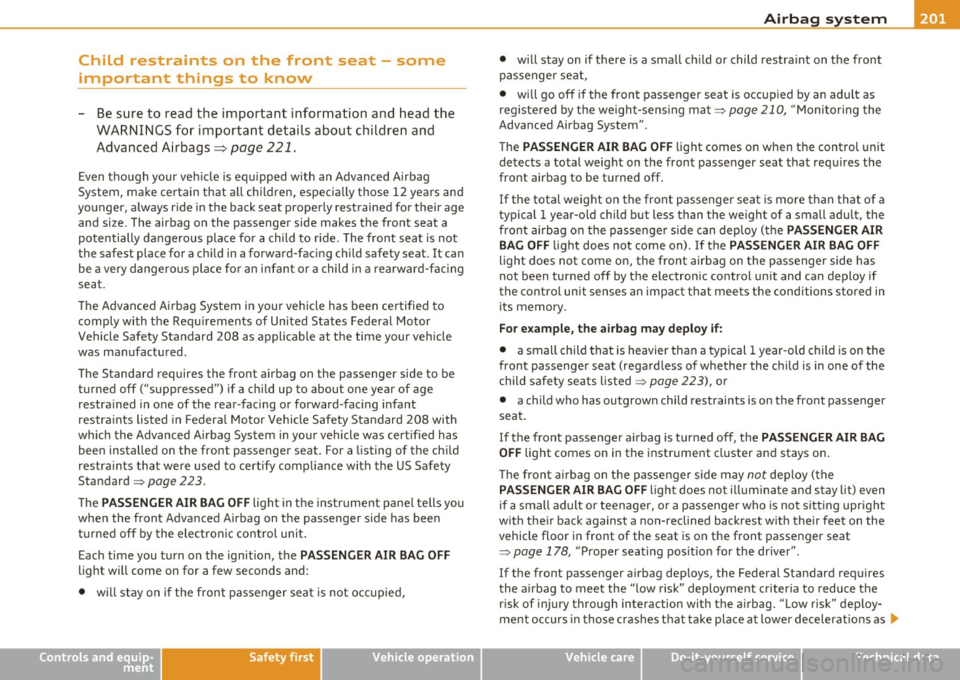
_________________________________________________ A_ ir_ b_ a_,,g :;..__ s-=y '"- s_ t_ e_ m __ _
Child restraints on the front seat - some
important things to know
- Be su re to re ad t he i mpo rt a nt i nfo rmation a nd head the
WA RNINGS fo r i mporta nt details about chil dre n and
Advanced Airbags ~
page 221.
Even t hough your ve hicle is eq uipped with an Advanced Airbag
System, ma ke ce rtain that a ll chi ld ren, especia lly those 12 years an d
younger, always r ide in the back seat prope rly rest rained fo r th eir age
and si ze. The airbag on the passenger side makes the front seat a
po tentially da ngerous place fo r a child to r ide. The fro nt seat is not
the safest place for a ch ild in a forward-facing child safety seat. It can
be a very dange rous place fo r an i nfan t or a child in a rearward-fac ing
seat.
Th e Advanced Ai rbag System in your vehicle has been cer tified to
comply with the Req uirements of Uni ted States Federa l Motor
Vehicle Safety Standard 208 as applicable at the time your veh icle
was ma nufact ured .
The Standard requires the front airbag on the passenger side to be tu rne d off ("s uppressed") if a c hild up to abou t one ye ar of age
restra ined in o ne of the rear -facing or forward -fac ing infant
restra ints listed in Fed era l Moto r Vehicle Safety Standard 208 with
whic h the Advanced Airbag System in yo ur vehicle was cert ified has
been installed on the front passenger seat. For a listing of the ch ild
restra in ts that were used to certify compliance with the US Saf ety
Standard =>
page 223.
The PASSENGER AIR BAG OFF ligh t in th e in st rume nt p anel t ells you
when the front Advanced A irbag on the passenger side has been
tur ned off by the ele ct ronic con trol uni t.
Each time you t urn on the ignition, t he
PASSENGER AIR BAG OFF
light will come on for a few seconds and:
• will stay on if th e front passenger se at is no t oc cupie d,
Controls and equip
ment Safety first
Vehicle operation
• will stay on if there is a small ch ild or child restra int on the front
p assenge r se at,
• will go off if the front passenger seat is occup ied by an adult as
reg iste red by t he weight -sens ing mat =>
page 210, "M oni tor ing t he
Advanced Airbag System" .
T he
PASSENGER AIR BAG OFF light comes o n when t he control unit
de tects a total weight on t he front passenger seat that req uires the
front airbag to be t urned off .
If th e total weight o n the front passenger seat is more than th at of a
typical 1 year-o ld child but less than the weight of a small adult, the
fr on t a ir bag on the passenge r si de c an deploy (t he
PASSENGER AIR
BAG OFF
light does not come on) . If the PASSENGER AIR BAG OFF
light does not come on, the front airbag on the passenger side has
not been turned off by the electronic co ntrol unit and can deploy if
the control unit senses an impact t hat meets the conditions stored in
its memory.
For example, the airbag may deploy if:
• a small child that is heavier than a typical 1 year -old child is on the
front passenger seat (rega rd less of whether the chi ld is in one of the
child safety seats listed =>
page 223), or
• a child who has outgrown child restraints is on the front passenger
sea t.
If the fro nt passenger a irbag is tur ned off, the
PASSENGER AIR BAG
OFF
lig ht comes on in the instr ument cluster an d stays on.
Th e fron t airbag on t he pa sse nger side may
not de ploy ( the
PASSENGER AIR BAG OFF li ght does not illum inate and stay lit) even
if a small a dult or teenager, o r a passenger who is no t sitti ng upright
with their back against a non-reclined backrest w ith the ir feet on the
vehicle floor in front of the seat is on the front passenger seat
=>
page 178, " P roper seat ing pos itio n for the dr iver".
If the front passenger ai rbag dep loys, the Federal Standard requires
t he a irbag to mee t the "low risk" deployme nt cr iter ia to reduce the
risk of inj ury through interaction with the a irbag. "Low r isk" deploy
me nt o ccurs in those cras hes t hat tak e pla ce a t lower decelerat io ns as
I),
Vehicle care Do-it-yourself service Technical data
Page 205 of 364
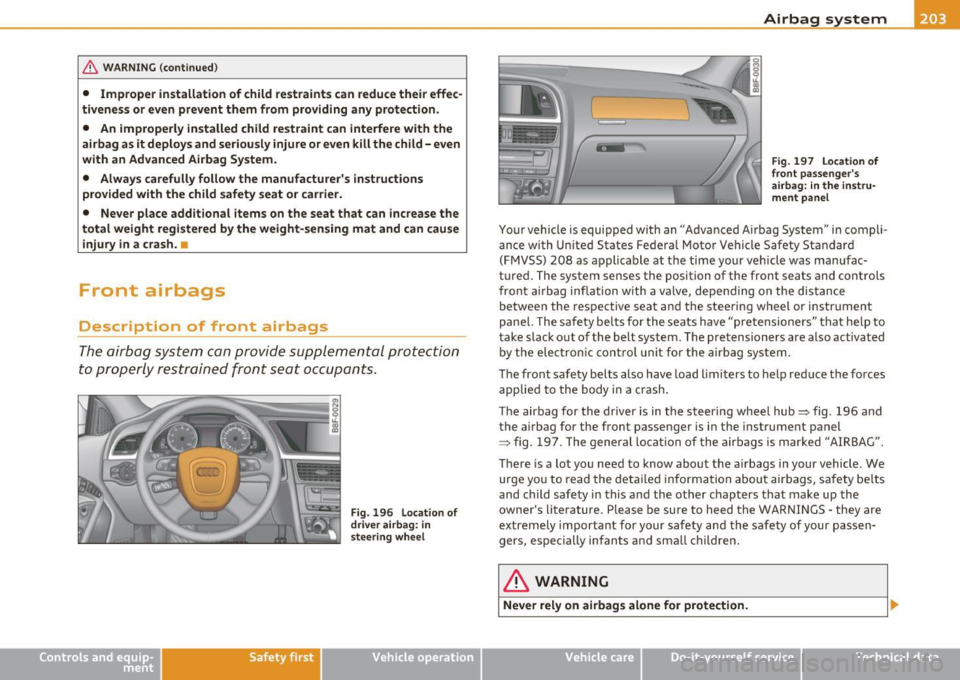
& WARNIN G (con tinued )
• Imprope r in stall ation of child re straints can redu ce their effec·
tiveness or even prevent them from providing any protection.
• An improperl y installed child re straint c an interfere with the
airbag a s it deploy s and seriously injure or even kill the child - even
with an Advanced Airbag Sy stem.
• Always carefully follow the manufacturer 's instruct ions
provided with the child safety seat or carrier.
• Ne ver place additional items on the seat that can increase the
total weight regi stered by the weight-sen sing mat and can cause
injury in a crash .•
Front airbags
Description of front airbags
T he airbag system can p rovide supplemental protection
to properly r estrained front se at oc cupants .
Safety first
Fig . 19 6 Locatio n of
drive r airb ag : in
s tee ring whee l
Vehicle OP-eration
Airbag system
Fig. 19 7 Locati on of
fr on t pass enge r's
a ir bag: in the instru
me nt pa nel
Yo ur vehicle is equi pped with an "Advanced A irbag Syst em" in compli ·
ance with United States Fe dera l Moto r Vehicle Safety Sta ndard
(FMVSS) 2 08 as a pplicable at t he time your vehi cle was manufac
t u red . The system senses the position of the front seats and controls
front a irbag infl ation w ith a va lv e , dep ending on th e distanc e
between the respective seat and the stee ring wheel or instrument
pane l. The safe ty belts fo r the seats have "prete ns ione rs" t hat he lp to
take slack out of the belt system. The p retensioners are also activated
by the elec tron ic control u nit for the air bag sys tem.
T he front s afe ty belts also have load limiters to help red uce the forces
applied to the body in a cras h.
Th e airbag for the driver is in the stee ring whee l hub::::> fig. 196 and
the ai rbag for the front passenger is in the inst rument panel
::::> fig. 19 7. T he ge neral lo cat io n of the air bags is m ark e d "A IRBAG".
Th ere is a lot you need to know about the a irbags in your vehicle. We
urge yo u to read the det ailed in forma tion abou t air bags, sa fety be lts
and child safety in this and the other chap ters tha t make u p the
owner's literature. Please be sure to heed the WARNINGS -they are
e xtremely importa nt f or your safety and the saf ety of your pas se n
gers, especially infants and sma ll ch ildren.
& WARNING
Never rely on airbags alone for protection.
Vehicle care Do-it-yourselt service iTechnical data
Page 207 of 364
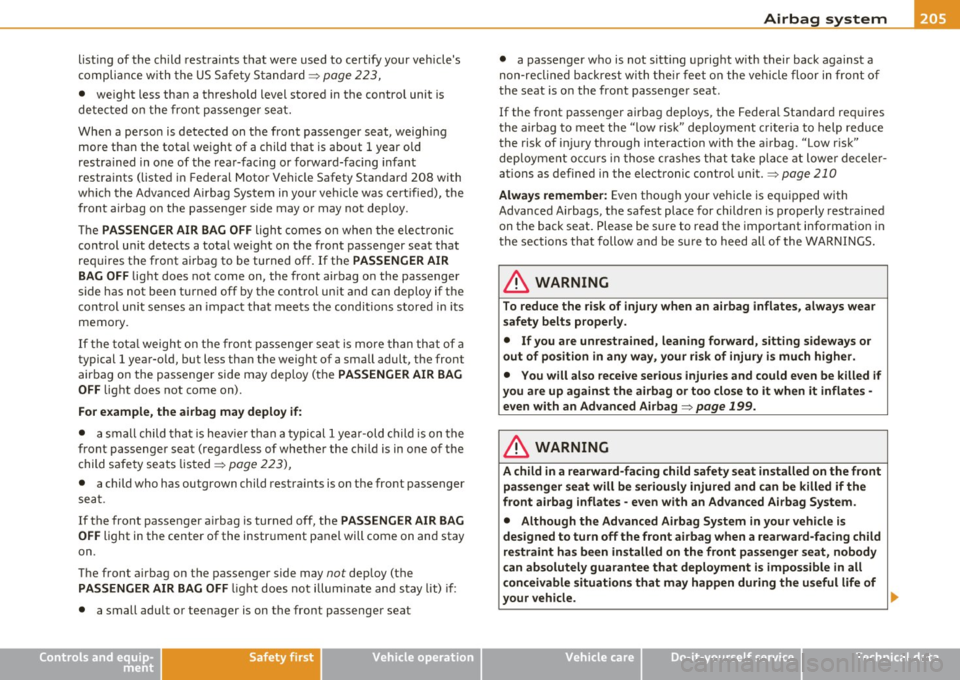
_________________________________________________ A_ ir_ b_ a_,,g :;..__ s-=y '"- s_ t_ e_ m __ _
listing of the child restraints that were used to certify your vehicle's
compliance with the US Safety Standard ~
page 22 3,
• weight less than a threshold level sto red in the contro l unit is
de tected o n the front p assenge r seat.
When a person is detected on t he front passenger seat, weigh ing
more tha n the tota l we ight of a child that is about 1 year old
restra ined in one of the rear-facing or forward-fac ing infant
restraints (listed in Federal Motor Ve hicle Safety Standard
208 with
w hich t he Advan ced Ai rbag System in your veh icle was cert ified), the
front airbag on the passenger s ide may or may not dep loy.
T he
PASSENGER AIR BAG OFF ligh t comes on when the elect ronic
control u nit detects a tota l weig ht on the front passenger seat that
req uires the front airbag to be turned off . If the
PASSENGER AIR
BAG OF F
light does not come on, the front airbag on the passenger
side has not been turned off by the control unit and can deploy if the
cont rol un it senses an impact that meets the conditions stored in its
memory.
If the tota l we ight on the fro nt passenger sea t is more than th at of a
typical
1 year-o ld, but less than the weight of a small adult, the front
airbag on the passenger side may dep loy (the
PASSENGER AIR BAG
OFF
light does not come on) .
For example, the airb ag may deploy if:
• a small child that is heav ie r than a typical 1 year-old child is on the
front passenger seat (regard less of whether the ch ild is in one of the
child safety seats listed ~
page 223),
• a child who has outgrown child restra ints is on the front passenger
sea t.
If the front passenger a irbag is turned off, the
PASSENGER AIR BAG
OFF
light in the center of the instr ument panel will come on and stay
on .
The front airbag on the passenger side may
not dep loy (the
PASSENGER AIR BAG OFF li ght does not i llumi nate and s tay lit) if:
• a small adult or teenager is on the front passenger seat
Controls and equip
ment Safety first Vehicle operation
•
a passenger w ho is not sitt ing uprig ht with their back against a
non-recline d backrest wi th t he ir feet on the veh icle floor in fro nt o f
the seat is o n the fro nt passenger seat.
If the front passenger airbag dep loys, the Federa l Standard requires
t he a irbag to mee t the " low ris k" deployment c riter ia to help reduce
the risk of injury through interaction with the a irbag. "Low risk"
dep loyment oc curs in those c rashes that ta ke p lace at lowe r de cele r
ations as defined in the electronic contro l unit.~
page 210
Alw ays remember: Even tho ugh your vehicle is eq uipped with
Advanced A irbags, the safest place for children is properly restrained
on the back seat. Please be sure to read the important information in
the sections t hat follow and be su re to heed all of the WAR NINGS.
& WARNING
To reduc e the ri sk of injury w hen an airbag inflate s, alwa ys w ear
safet y belt s properly .
• If you are unrestrained, leaning forward , sitting sidewa ys or
out of po sition in any way , your ri sk of injury i s much high er.
• You will also recei ve serious injurie s and could even be killed if
you are up again st the airbag or too close to it wh en it inflates -
e ven with an Ad vanced Airbag ~
page 199.
& WARNING
A child in a rearward-facing child safety seat installed on the front
pa ssenger seat will be seriou sly injured and can be killed if the
front a irbag inflates · even with an Advanced Airbag System .
• Although the Ad vanced Airb ag System in your v ehicle is
designed to turn off the front airbag when a rearward-facing child
re straint has been installed on the front pas senger seat , nobody
c an absolut ely guarantee th at deployment is impo ssible in all
c onceivable situation s that may happen during the u seful life of
your vehicle. _,.
Vehicle care Do-it-yourself service Technical data
Page 208 of 364

ffl..,___A_ i_rb _ a_,g,:;._ s_, y'- s_ t_e _m ________________________________________________ _
& WARNING (conti nued)
• The inflating ai rbag will hit the child safety seat or infant
carrier with gr eat force and will sma sh the child safety seat and
c hild again st the backrest , center armrest , door , or roof.
• Alway s install rearward-facing child restraints in the back seat.
• If you must install a rearward facing child safety seat on the
front passenger seat because of e xceptional circumstances and
the PASSENGER AIR BAG OFF light does not come on and stay on ,
immediately install the rear-facing child safety seat in a rear
s eating po sition and have the airbag system inspected by your
authorized Audi dealer .
& WARNING
If, in except ional circumstances, you must install a forward-facing
child restraint on the front pas senger' s seat:
• Always make sure the forward-fac ing se at has been designed
and certified by its manufacturer for u se on a front seat with a
passenger front and side airbag.
• Never put the forward -facing child restraint up against or very
near the instrument panel.
• Alway s move the passenger seat into it s rearmost position
in
the seat 's fore and aft adjustment range, as far away from the
airbag a s possible, before in stalling the forward -facing child
restraint. The back rest must be adjusted to an upright position.
• Make sure that the PASSENGER AIR BAG OFF light comes on
and stays on all the t ime whenever the ignition is switched on .•
Advanced Airbag System components
Th e front passenger seat in your veh icle has a lot of very important
parts of t he A dvanced A irbag System in it. These parts incl ude t he
we ight-sens ing mat, sensors, wiring, brackets, and more. The func- tion of the system
in the front passenger seat is checked by the elec
t ronic c ontro l unit w hen the ignitio n is o n. The contr ol unit mon itors
t he Advanced Airbag System and tu rns the airbag indicato r light o n
w hen a malfunction in t he system components is detected. The func
t ion of the a irbag indicator light is descr ibed in greater deta il below .
Because the front passenge r seat co nta ins impo rtant parts of t he
Adva nced Ai rbag System, you must ta ke care to p reve nt i t from be ing
damaged. Damage to the seat may p revent the A dvanced A irbag for
t he fro nt passenge r se at from do ing its job in a crash.
The front Advanced Airbag System consists of the
following:
• Cras h sensors in the front of t he vehicle that measu re vehicle
a cc ele ration/de ce le ra tion to provi de i nfo rm ation to the Advanced
Airbag System about the severity of the crash .
• An e lec tron ic contro l unit, w it h i ntegrated crash sensors fo r front
and side impacts. The contro l unit "dec ides" w het her to fire the front
a irbag s based o n the inform ation receive d fro m t he c rash se nso rs.
The contro l unit also "decides" whether the safety be lt pretens ioners
shoul d be activ at ed .
• An Advanced Air bag with gas generator and control va lve for the
dr ive r in side t he steering wheel hub.
• An Advanced Air bag with gas generator and control va lve inside
t he inst rument pa ne l for the fron t passenge r.
• A weight-sensi ng mat unde r th e up ho ls tery pad ding of the front
passenger s eat cushion that measures the tota l we igh t on the seat .
Th e informat io n registered is sent continuous ly to the elect ronic
con trol unit to regulate deployment of t he front Advanced A irbag o n
the passenger side.
• An airbag mon itoring system a nd ind icator light in the ins trument
cl uster => page
210 .
• A senso r in each front seat reg isters the distance between the
res pective sea t and t he steeri ng whee l o r i nst rument p ane l. T he
info rmation reg iste red is sent co ntin uously to the e lectronic con trol
uni t to reg ulate dep loyment of the front Advanced Air bags . ..,
Page 209 of 364

_______________________________________________ A_ ir_ b_ a_,,,g ~ s,,._y _s _t_ e _ m ___ lJ'II
• The PASSENGER AIR BAG OFF light comes on and stays on in the
c en ter o f the inst ru me nt pane l=>
page 211, fig. 199 a nd t ells you
when the front Advanced A irbag on t he passe nger side has been
t u rne d off.
• A sensor below the safety belt latch for the front seat passenger
t o meas ure t he tension on t he s afety be lt. T he tension on the s afety
belt and the we ight registe red by the weight-sensing mat help t he
cont rol unit " deci de" whether the front a irbag for the front
passenge r seat should be tur ned off o r not=>
page 201, "C hild
restraints on the front seat -some important things to know".
• A se nso r in the safety bel t latch for the driver a nd fo r the front
seat passenge r that senses whether that safety belt is latched or not
and transmits this information to t he e lec tron ic control un it .
& WARNING
Damage to the front passenger seat can prevent the front airbag
from working properl y.
• Improper repair or disassembly of the front passenger and
driver seat will prevent the Advanced Airbag System from func
tioning properly.
• Repairs to the front pa ssenger seat must be performed by qual
ified and properly trained workshop personnel.
• Never remove the front passenger or driver seat from the
vehicle.
• Never remove the upholstery from the front passenger seat .
• Never disassemble or remove parts from the seat or disconnect
wires from it .
• Never carry sharp objects in your pockets or place them on the
seat . If the weight-sensing mat in the passenger seat is punctured
it cannot work properly.
• Never carry th ings on your lap or carry objects on the passenger
seat. Such items can in crease the weight registered by the weight
sensing mat and send the wrong information to the airbag control
unit.
Controls and equip ment Safety first Vehicle operation
& WARNING
(co ntinued )
• Never store item s under the front passenger seat . Parts of the
Advanced Airbag Sy stem under the passenger seat could be
damaged , preventing them and the airb ag system from working
properly .
• Never place seat covers or replacement upholstery that have
not been specifically approved by Audi on the front seats .
• Seat cover s can prevent the Advanced Airbag System from
recognizing child re straints or occupants on the front passenger
seat and prevent the side airbag in the seat backrest from
deploying properly .
• Never u se cushions, pillow s, blankets or similar items on the
front passenger seat. The additional padding will prevent the
weight-sensing mat in the seat from ac curately registering the
child restraint or person on the seat and prevent the Advanced
Ai rbag System from functioning properly .
• If you must use a child restraint on the front passenger seat
and the child restraint manufacturer's instructions require the use
of a towel, foam cushion or something else to properly position
the child restraint, make certain that the PASSENGER AIR BAG
OFF light comes on and stays on whenever the ch ild restraint is
installed on the front passenger seat.
• If the PASSENGER AIR BAG OFF light does not come on and
stay on, immediately install child restraint in a rear seating posi
tion and have the airbag system inspected by your authorized Audi dealer. •
How the Advanced Airbag System
components work together
Th e fron t Adva nced A irbag System and t he side air bags supp lemen t
t he p ro tec tion offered by the front three- po int safety belts with
pretens ioners and load limiters and t he adjusta ble head restra ints to
help reduce the risk of injury in a w ide rang e of acc iden t and crash ..,.
Vehicle care Do-it-yourself service Technical data